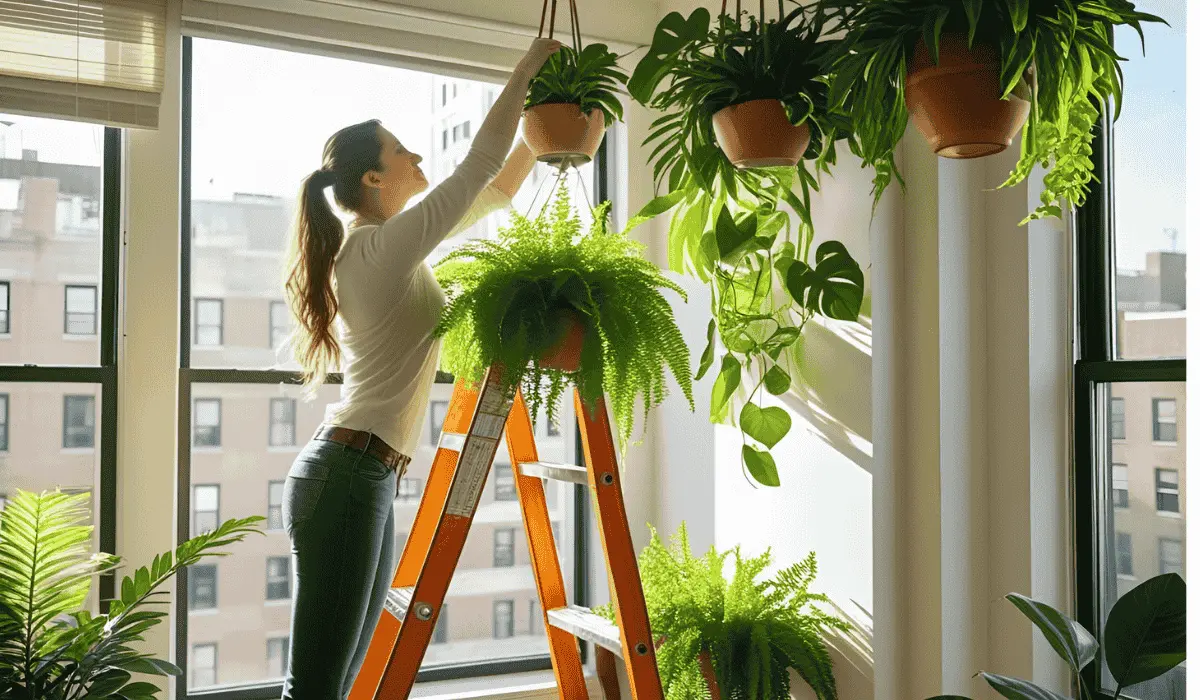I work with all kinds of plants As a gardener, hanging plants always attract me for their beauty and benefits.
Hanging plants enhance beauty in our room without taking too much space. It makes our room more lively.
Along with beauty, we also have to look at safety
However, ensuring that these plants are safely and securely hung is important.
To prevent accidents, also maintain the health of the plants. In this comprehensive guide, we will explore the essential steps about How to hang plants safely and securely And what kind of problem did I face when I was a beginner?
Let’s start with the right plant and pot to solve common issues.
Ways to Hang indoor plants safely
1. Choosing the Right Plant and Pot
Select Plant Size and Weight
Before hanging plants, select the weight and size of the plant. A delicate fern will require different support than a sturdy pothos.
Light and Water Requirements
Make sure the hanging location provides enough light and access to water for your plant’s specific needs.
2. Selecting the Ideal Hanging Location
Sunlight and Air Circulation
Choose a spot that provide right amount of sunlight and good air circulation to keep your plant healthy and happy.
Measuring Ceiling Height and Structure
Take into account the height of your ceiling and the structure of your home to ensure safe and secure hanging.
3. Tools and Materials
List of Essential Tools
Gather tools such as a drill, screwdriver, measuring tape, and level for a successful plant hanging project.
Recommended Hanging Hardware
Buy sturdy hooks, brackets, or hangers designed to support the weight of your plant and pot.
4. Installing Ceiling Hooks or Plant Hangers
Finding Studs or Support Beams
Find studs or support beams in your celing to ensure a strong achhor point for hanging
Proper Installation Techniques
maintainain proper installation techniques to securely hang your plant to avoid any kind of accidents. Remember, we’re going for stylish, not suspenseful!
5. Securing Hanging Plants in Different Environments
How to Hang Plants Indoor
Make sure your plant isn’t too heavy for where you’re hanging it. A strong hook that goes into a wooden beam in your ceiling or wall works best. If you ar not sure where the beams, use a stud finder to locate them. The hook should be able to hold more weight than your plant and pot together.also u can use a hanging plant self.
Keep your hanging plants away from air vents, the rushing air can dry them out and make their leaves dry. Also, don’t put them right in front of windows where the sun shines in directly. Too much sun can burn their leaves and make them look sad.
Check every few months that your hook is still tight and strong. Give it a gentle wiggle – if it moves at all, it’s time to fix it or find a better spot.
How to Hang Plants Outdoor
For outdoor hanging plants, choose weather-resistant materials for hooks and hangers to withstand the elements. Be mindful of wind conditions and secure plants properly to prevent them from swinging excessively. Check for adequate drainage to prevent waterlogging
6. Maintaining the Health and Safety of Hanging Plants
Watering and Fertilizing for indoor plants
Establish a consistent watering schedule based on plant requirements, ensuring proper drainage to prevent root rot. Use a balanced fertilizer according to plant type and season to ensure healthy growth. Monitor soil moisture levels regularly.
Monitoring for Pests and Diseases
Inspect hanging plants frequently for signs of pests like spider mites or aphids. Treat infestations promptly with natural or chemical solutions. Watch for symptoms of diseases such as yellowing leaves or mold, and take appropriate action to prevent spreading.
7.Solve Common Issues
Drooping hanging Plants
If your hanging plants start sag or droop, check for overwatering and insufficient light exposure, or root-bound conditions. Adjust watering frequency, provide proper sunlight, and consider repotting if roots are overcrowded.
Overwatering or Underwatering
Yellowing leaves are signs of overwatering, while underwatering may cause dry soil. Adjust watering habits continuously, allowing the soil to dry out between waterings but not to the point of dehydration.
8. Creative Display Ideas for Hanging Plants
Utilizing Different Heights and Groupings
Create visual interest by hanging plants at varying heights to add depth to your space. Group different plant species with complementary care requirements to showcase a diverse botanical display.
9. Hanging Air plant Holder
DIY plant hanging solutions
without diy plant hanger your room decor is incomplete, DIY hangers Enhance the aesthetic appeal of your hanging plants, try to crafting your own DIY hangers for a better and more aesthetic look. Personalize designs to match your decor style and experiment with different knotting techniques for a unique look.
I think following the tips, you can confidently hang plants in your home or outdoor space now, because i explain the full guide for best ways to hang plants and How do you safely hang plants?
you know that they are secure and well-maintained. Remember, regularly check on your hanging plants, provide them with the necessary care, and enjoy the beauty and benefits they bring to your environment with the right knowledge.
FAQs
Q: How do I know if my ceiling can hold plants?
A: I always check for studs first. For drywall, use anchors rated for 2x your plant’s weight. I’ve never had a failure using this method.
Q: My plants keep dying. What’s wrong?
A: In my experience, it’s usually overwatering. Feel the soil before watering. Wait until the top inch is dry.
Q: How often should I water hanging plants?
A: It varies. My tropical plants need water twice weekly. Succulents only need monthly watering. Watch your plants—they’ll tell you.
Q: Can I hang plants in my bathroom?
A: Absolutely! I have ferns thriving in mine. Use rust-resistant hooks and moisture-loving plants.
Q: What’s the easiest hanging plant for beginners?
A: Start with pothos. They’re forgiving and tell you when they need water. I’ve never seen one fail completely.
Q: How do I water tall hanging plants?
A: I use a long-necked watering can. Or make a pulley system – I did this in my greenhouse.
Remember: Start small. Learn from each plant. Don’t be afraid to adjust your approach
Q: Can I use low light plants as hanging plants?
A: yes, you can use low light plants as hanging plant. But u have to know which low light plants do better in low light condition.


